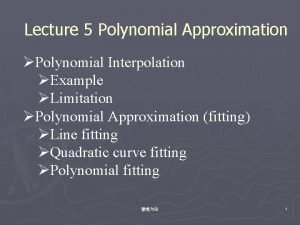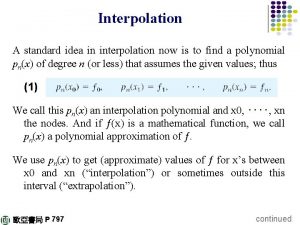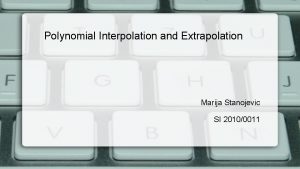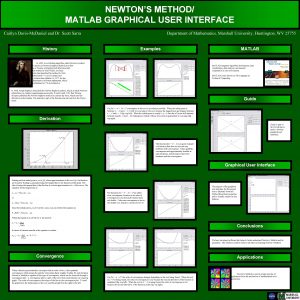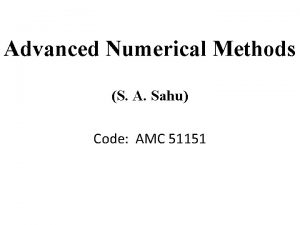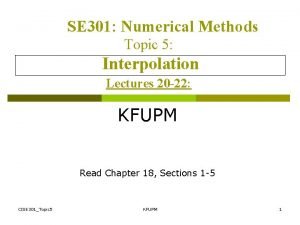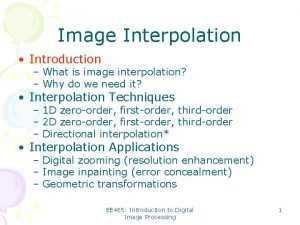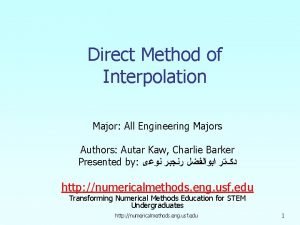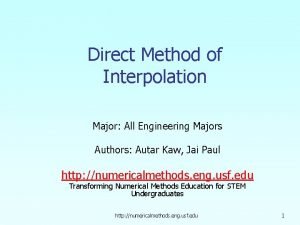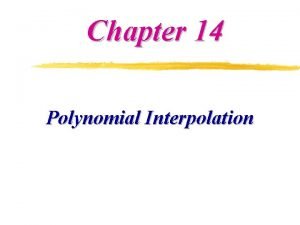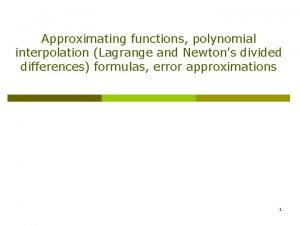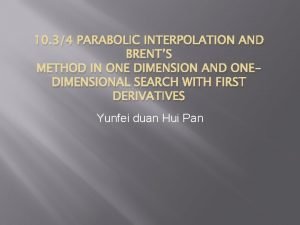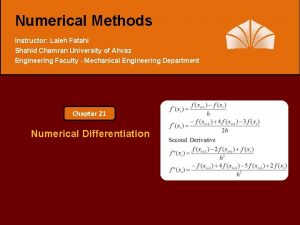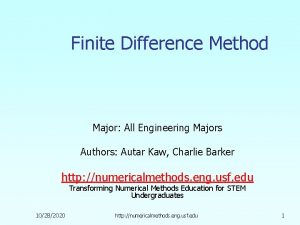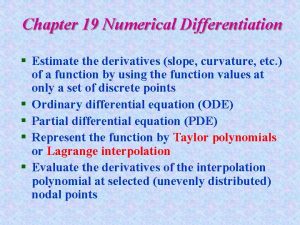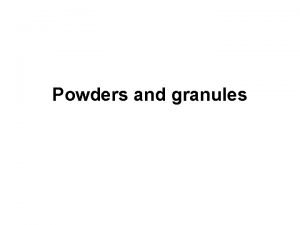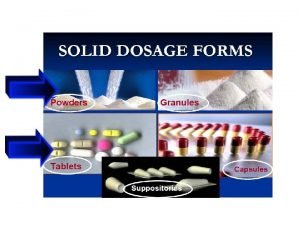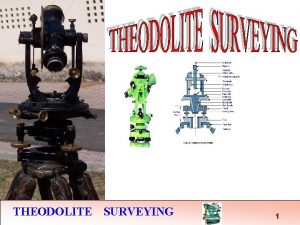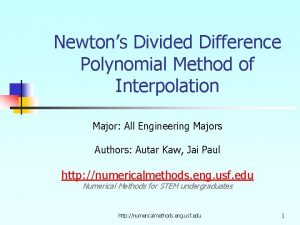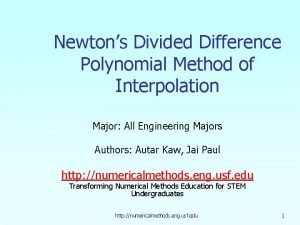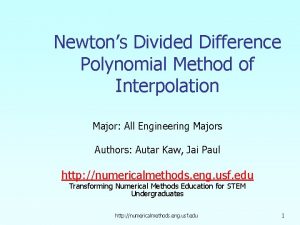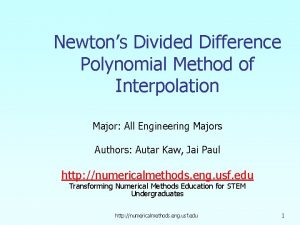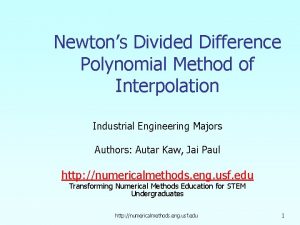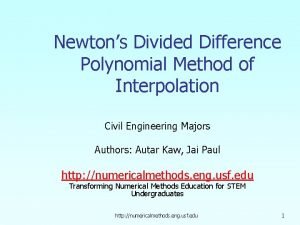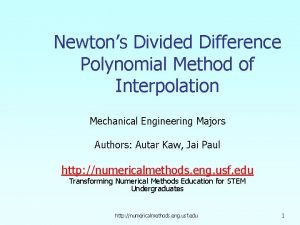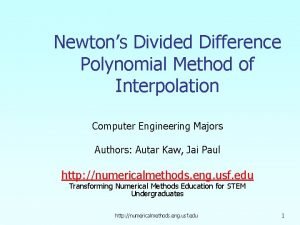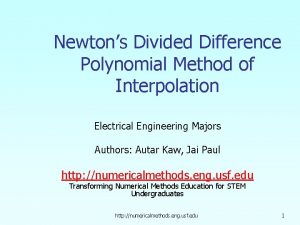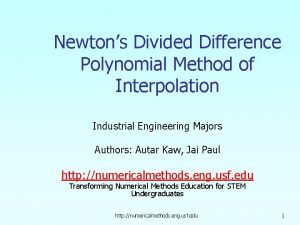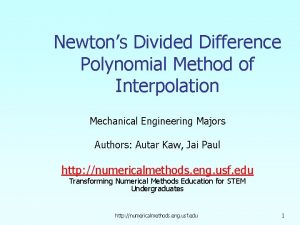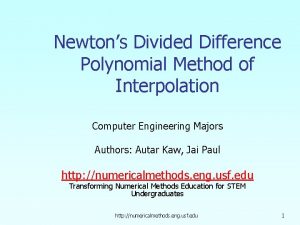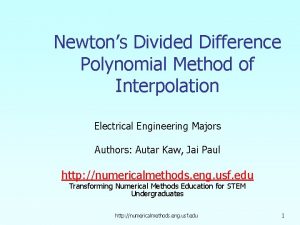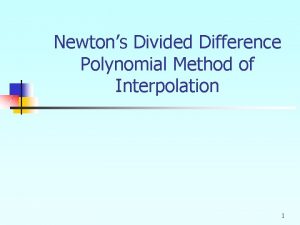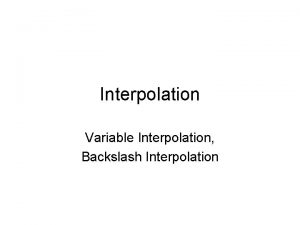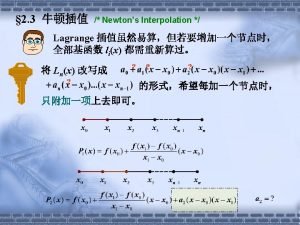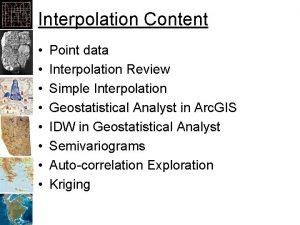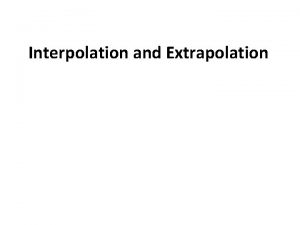Newtons Divided Difference Polynomial Method of Interpolation Major

























- Slides: 25

Newton’s Divided Difference Polynomial Method of Interpolation Major: All Engineering Majors Authors: Autar Kaw, Jai Paul http: //numericalmethods. eng. usf. edu Transforming Numerical Methods Education for STEM Undergraduates http: //numericalmethods. eng. usf. edu 1

Newton’s Divided Difference Method of Interpolation http: //numericalmethods. eng. usf. edu

What is Interpolation ? Given (x 0, y 0), (x 1, y 1), …… (xn, yn), find the value of ‘y’ at a value of ‘x’ that is not given. 3 lmethods. eng. usf. edu http: //numerica

Interpolants Polynomials are the most common choice of interpolants because they are easy to: Evaluate Differentiate, and Integrate. 4 lmethods. eng. usf. edu http: //numerica

Newton’s Divided Difference Method Linear interpolation: Given linear interpolant through the data pass a where 5 lmethods. eng. usf. edu http: //numerica

Example The upward velocity of a rocket is given as a function of time in Table 1. Find the velocity at t=16 seconds using the Newton Divided Difference method for linear interpolation. Table. Velocity as a function of time 0 10 15 20 22. 5 30 6 0 227. 04 362. 78 517. 35 602. 97 901. 67 Figure. Velocity vs. time data for the rocket examplelmethods. eng. usf. edu http: //numerica

Linear Interpolation 7 lmethods. eng. usf. edu http: //numerica

Linear Interpolation (contd) 8 lmethods. eng. usf. edu http: //numerica

Quadratic Interpolation 9 lmethods. eng. usf. edu http: //numerica

Example The upward velocity of a rocket is given as a function of time in Table 1. Find the velocity at t=16 seconds using the Newton Divided Difference method for quadratic interpolation. Table. Velocity as a function of time 0 10 15 20 22. 5 30 10 0 227. 04 362. 78 517. 35 602. 97 901. 67 Figure. Velocity vs. time data for the rocket examplelmethods. eng. usf. edu http: //numerica

Quadratic Interpolation (contd) 11 lmethods. eng. usf. edu http: //numerica

Quadratic Interpolation (contd) 12 lmethods. eng. usf. edu http: //numerica

Quadratic Interpolation (contd) 13 lmethods. eng. usf. edu http: //numerica

General Form where Rewriting 14 lmethods. eng. usf. edu http: //numerica

General Form 15 lmethods. eng. usf. edu http: //numerica

General form 16 lmethods. eng. usf. edu http: //numerica

Example The upward velocity of a rocket is given as a function of time in Table 1. Find the velocity at t=16 seconds using the Newton Divided Difference method for cubic interpolation. Table. Velocity as a function of time 0 10 15 20 22. 5 30 17 0 227. 04 362. 78 517. 35 602. 97 901. 67 Figure. Velocity vs. time data for the rocket examplelmethods. eng. usf. edu http: //numerica

Example The velocity profile is chosen as we need to choose four data points that are closest to 18 lmethods. eng. usf. edu http: //numerica

Example 19 lmethods. eng. usf. edu http: //numerica

Example 20 lmethods. eng. usf. edu http: //numerica

Comparison Table 21 lmethods. eng. usf. edu http: //numerica

Distance from Velocity Profile Find the distance covered by the rocket from t=11 s to t=16 s ? 22 lmethods. eng. usf. edu http: //numerica

Acceleration from Velocity Profile Find the acceleration of the rocket at t=16 s given that 23 lmethods. eng. usf. edu http: //numerica

Additional Resources For all resources on this topic such as digital audiovisual lectures, primers, textbook chapters, multiple-choice tests, worksheets in MATLAB, MATHEMATICA, Math. Cad and MAPLE, blogs, related physical problems, please visit http: //numericalmethods. eng. usf. edu/topics/newton_div ided_difference_method. html

THE END http: //numericalmethods. eng. usf. edu
 Spline interpolation vs polynomial interpolation
Spline interpolation vs polynomial interpolation Lagrange's interpolation formula
Lagrange's interpolation formula Newton backward interpolation formula
Newton backward interpolation formula Neville polynomial interpolation
Neville polynomial interpolation Polynomial interpolation
Polynomial interpolation Matplotlib inline
Matplotlib inline How to divide a polynomial by another polynomial
How to divide a polynomial by another polynomial Newtons method matlab
Newtons method matlab Newton's divided difference
Newton's divided difference Stirling formula interpolation
Stirling formula interpolation Linear extrapolation example
Linear extrapolation example Interpolasi
Interpolasi Linear interpolation formula
Linear interpolation formula Direct method interpolation
Direct method interpolation Direct method of interpolation
Direct method of interpolation Quadratic interpolation method
Quadratic interpolation method Lagrange method interpolation
Lagrange method interpolation Parabolic interpolation
Parabolic interpolation Finite divided difference
Finite divided difference Finite divided difference
Finite divided difference Finite divided difference
Finite divided difference Granules advantages and disadvantages
Granules advantages and disadvantages Define geometric dilution in pharmaceutics
Define geometric dilution in pharmaceutics Difference between bulk powder and divided powder
Difference between bulk powder and divided powder Wet gum and dry gum method
Wet gum and dry gum method Measurement of horizontal angle by ordinary method
Measurement of horizontal angle by ordinary method
